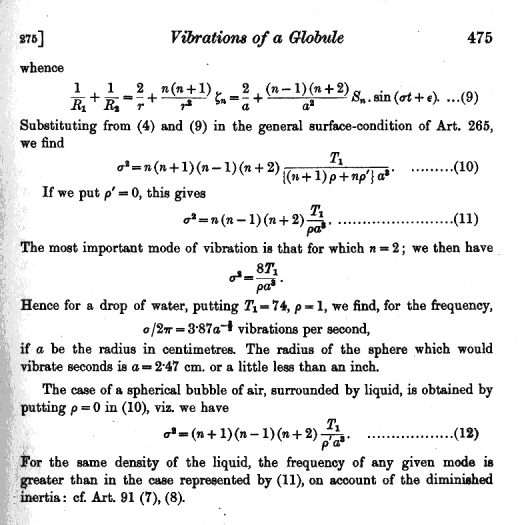Today, a 120-year journey into space. The University of Houston's College of Engineering presents this series about the machines that make our civilization run, and the people whose ingenuity created them.
Horace Lamb, son of a British cotton-mill developer, was born in 1849 and raised by a Puritan aunt. He found his way to Cambridge University, where he studied under both Maxwell and Stokes -- familiar names if you've ever studied fluid mechanics. Lamb was very bright, and he stayed on as a junior faculty member.
But junior faculty at Cambridge had to remain celibate. So, in 1875, 26-year-old Horace Lamb married his aunt's young sister-in-law and moved to the new University of Adelaide in Southern Australia. In his ten years there he proved to be a superb lecturer.
Lamb was teaching in Adelaide when he published his Hydrodynamics, the finest and longest-lasting fluid mechanics text ever written. Lamb edited the sixth edition of that book 53 years later, when I was a toddler. I studied from Lamb's Hydrodynamics in the 1960s, and it's still in print! Another person who studied Lamb's wonderful old book, long after I did, was astronaut Andrew Thomas. And, even as I write this episode, Thomas is up on the Mir Space Station studying the subtle movements of liquids when they're freed from gravity -- when they have literally shaken off the surly bonds of earth.
Now the surprise: Thomas did his Ph.D. in fluid mechanics at the University of Adelaide. He took his courses in the Horace Lamb Lecture Theatre there. I suppose that could pass for simple coincidence. But not after you've read Lamb's astonishing book.
Read about the equations for surface-tension waves and liquid-vapor stability. After I'd read Lamb, NASA engaged me to study the mechanisms of vapor removal from a heater as gravity is removed. For twenty years I worked on those problems, always with Lamb at my elbow. Now Thomas writes this from Mir:
I easily create perfect spheres of water floating in front of me. I inject air into one and make a spherical shell of water, using the self-centering action of surface tension forces. I watch water climb the length of soda straw under the force of surface tension unopposed by gravity. All this was described by Lamb.
The great problem posed by liquid in a space vehicle is making it go where you want it to go. NASA uses the old English word ullage, which once referred to the empty space in a wine keg. Whether you're dealing with a liquid oxygen container, a water tank, or an orange juice bag, you won't get liquid out unless it finds its way around the empty ullage space to the spigot.
When we read Lamb's 120-year-old bible of fluid behavior, we know he's up there on Mir, along with Andy Thomas, helping us to make liquids behave without the guiding hand of gravity. Is all this mere coincidence? Of course it is. But that doesn't stop me from seeing the ghost of one the great teachers of all time come back to guide other hands long after his death. For doesn't the ghost of any great teacher always do just exactly that?
I'm John Lienhard, at the University of Houston, where we're interested in the way inventive minds work.
(Theme music)
Lamb, Sir H., Hydrodynamics. 5th ed., New York: Dover Publications, 1945. (This is my battered old copy. But you can get a clean new copy even today -- in 1998.)
I am grateful to astronaut Andrew Thomas, who was not on this Earth when he suggested Lamb as a topic and provided additional counsel for it.

Andrew Thomas at work
Image courtesy of NASA

A passage from Lamb's venerable Hydrodynamics text